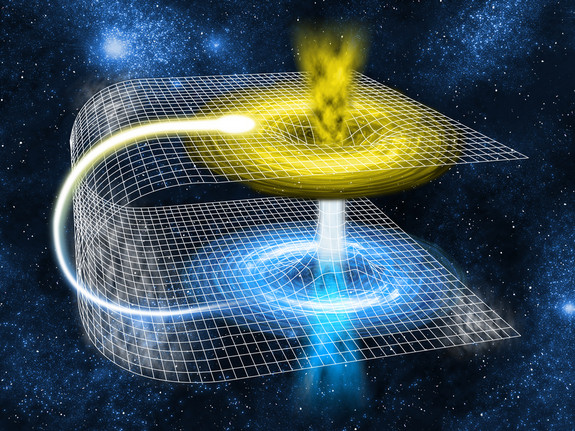In a new study, scientists say they can explain dark matter by positing a particle that links to a fifth dimension.
(Updated version of the previous article.)
While the “warped extra dimension” (WED) is a trademark of a popular physics model first introduced in 1999, this research, published in The European Physical Journal C, is the first to cohesively use the theory to explain the long-lasting dark matter problem within particle physics.

Our knowledge of the physical universe relies on the idea of dark matter, which takes up the vast majority of matter in the universe. Dark matter is a kind of pinch hitter that helps scientists explain how gravity works, because a lot of features would dissolve or fall apart without an “x factor” of dark matter. Even so, dark matter doesn’t disrupt the particles we do see and “feel,” meaning it must have other special properties as well.
“[T]here are still some questions which do not have an answer within the [standard model of physics],” the scientists, from Spain and Germany, explain in their study. “One of the most significant examples is the so-called hierarchy problem, the question why the Higgs boson is much lighter than the characteristic scale of gravity. [The standard model of physics] cannot accommodate some other observed phenomena. One of the most striking examples is the existence of dark matter.”
The new study seeks to explain the presence of dark matter using a WED model. The scientists studied fermion masses, which they believe could be communicated into the fifth dimension through portals, creating dark matter relics and “fermionic dark matter” within the fifth dimension.

Could dimension-traveling fermions explain at least some of the dark matter scientists have so far not been able to observe? “We know that there is no viable [dark matter] candidate in the [standard model of physics],” the scientists say, “so already this fact asks for the presence of new physics.”
Basically, a key piece of mathematics creates bulk masses of fermions that are manifested in the so-called fifth dimensional warped space. This pocket “dark sector” is one possible way to explain the huge amount of dark matter that, so far, has eluded detection using any traditional measurements designed for the standard model of physics. Fermions jammed through a portal to a warped fifth dimension could be “acting as” dark matter.
How would we observe this kind of dark matter in order to verify it? To date, this is the holdup on many different theories of dark matter. But all it would take to identify fermionic dark matter in a warped fifth dimension would be the right kind of gravitational wave detector, something growing in prevalence around the world. Indeed, the answer to the dark matter conundrum could be just around the corner.